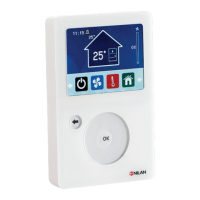
Do you have a question about the nilan Compact P CTS700 and is the answer not in the manual?
| Brand | nilan |
|---|---|
| Model | Compact P CTS700 |
| Category | Thermostat |
| Language | English |
Lists and describes the different types of ventilation units available.
Details the location and purpose of each temperature sensor in the Compact P unit.
Explains how to navigate menus and use the control panel buttons.
Illustrates and explains the various icons and data shown on the display.
Outlines the four distinct user levels and their access privileges.
Controls the overall ventilation speed up and down.
Adjusts fan speed based on air humidity levels.
Manages fan speed during cooling operations.
Reduces fan speed when outdoor temperature is low.
Adjusts fan speed based on indoor CO₂ levels.
Sets the target room temperature for the ventilation system.
Sets minimum and maximum supply air temperatures.
Configures parameters for replacing air filters.
Sets up filter monitoring based on time or pressure.
Pauses ventilation operation temporarily.
Displays the current operating status of the ventilation system.
Selects different modes for system operation.
Configures temperature thresholds for seasonal mode changes.
Assigns sensors for temperature readings.
Adjusts various parameters for precise temperature regulation.
Manages the automatic process to prevent ice buildup.
Configures pre-heating elements for frost protection.
Configures fan speed and air volume settings.
Configures settings related to an installed heating coil.
Controls an external heating system.
Configures blocking functions for heating or cooling.
Integrates the system with external fire automation.
Manages compressor operation intervals and parameters.
Sets the desired temperature for domestic hot water.
Controls the electric heater for supplementary hot water.
Sets minimum and maximum temperature limits for the tank.
Temporarily stops hot water production.
Configures the system for legionella bacteria prevention.
Instructions for safely turning off the entire ventilation system.
How to review and acknowledge system events, warnings, and alarms.
Reading current operational status of various system components.
Programming the system to follow specific weekly behavior patterns.
Utilizing external signals to override standard system programs.
Adjusting display light intensity and timeout settings.
Changing between Superuser, Installer, and Administrator levels.
Setting up password protection for Superuser functions.
Restricting user ability to change system settings.
Changing the language displayed on the control panel interface.
Verifying which ventilation unit the control panel is configured for.
Checking current software version and performing updates.
Configuring IP addresses and network settings for system access.
Saving, restoring, and resetting system settings and configurations.
Alarms that halt or critically impact system operation.
Alerts for potential issues requiring attention or monitoring.
Notifications about normal operation or non-critical events.